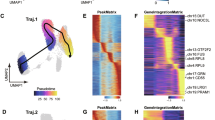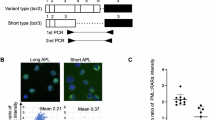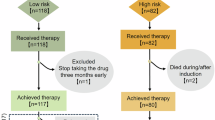Abstract
Arsenic trioxide (As2O3) effectively induces clinical remission via apoptosis in relapsed acute promyelocytic leukemia (APL). However, because this new anti-leukemic drug is also considered to be a poison, its possible adverse effects are a highly important issue related to its clinical use. We here investigated, both in vitro and in vivo, the effects of a combination of As2O3 and GM-CSF as a novel therapeutic approach for the treatment of APL. Treatment of both retinoic acid (RA)-sensitive and -resistant APL cell lines (NB4 and UF-1 cells, respectively), as well as primary APL cells with a combination of As2O3 and GM-CSF for 4 days resulted in inducing differentiation, but not apoptosis, to mature granulocytes. In addition, a combination of both agents induced degradation of the PML/RARα protein. GM-CSF was found to be associated with increased tyrosine phosphorylation of Jak2 kinase in both NB4 and UF-1 cells, and a specific inhibitor of Jak2, AG490, completely blocked the ability of GM-CSF to prevent apoptosis and induce differentiation of As2O3-treated UF-1 cells. In in vivo analysis, As2O3 induced differentiation of APL cells in a RA-resistant APL model of human GM-CSF-producing transgenic SCID mice that had a high level of human GM-CSF in their sera. In contrast, As2O3 alone diminished tumors in UF-1 cells transplanted into NOD/SCID mice via induction of apoptosis. In conclusion, a combination of As2O3 and GM-CSF appears to be a novel differentiation-inducing therapy in patients with APL, including relapsed or RA-resistant cases.
This is a preview of subscription content, access via your institution
Access options
Subscribe to this journal
Receive 12 print issues and online access
$259.00 per year
only $21.58 per issue
Buy this article
- Purchase on SpringerLink
- Instant access to full article PDF
Prices may be subject to local taxes which are calculated during checkout







Similar content being viewed by others
References
Kakizuka A, Miller WH Jr, Umesono K, Warrell RP Jr, Frankel SR, Murty VVVS, Dmitrovsky E, Evans RM . Chromosomal translocation t(15;17) in human acute promyelocytic leukemia fuses RARα with a novel putative transcription factor, PML Cell 1991 66: 663–674
de Thé H, Lavau C, Marchio A, Chomienne C, Degos L, Dejean A . The PML-RAR alpha fusion mRNA generated by the t(15;17) translocation in acute promyelocytic leukemia encodes a functionally altered RAR Cell 1991 66: 675–684
Grignani F, Ferrucci PF, Testa U, Talamo G, Fagioli M, Alcalay M, Mencarelli A, Grignani F, Peschle C, Nicoletti I . The acute promyelocytic leukemia specific PML/RARα protein inhibits differentiation and promotes survival of myeloid precursor cells Cell 1993 74: 423–431
Grignani F, Testa U, Fagioli M, Barkeri T, Masciulli R, Marinari G, Peschle C, Pelicci PG . Promyelocytic leukemia-specific PML-retinoic acid alpha receptor fusion protein interferes with erythroid differentiation of human erythroleukemia K562 cells Cancer Res 1995 55: 440–443
Raelson JV, Nervi C, Rosenauer A, Benedetti L, Monczak Y, Pearson M, Pelicci PG, Miller WH . PML/RARα oncoprotein is a direct molecular target of retinoic acid in acute promyelocytic leukemia cells Blood 1996 88: 2826–2832
Yoshida H, Kitamura K, Tanaka K, Omura S, Miyazaki T, Hachiya T, Ohno R, Naoe T . Accelerated degradation of PML-retinoic acid receptor α (PML-RARα) oncoprotein by all-trans-retinoic acid in acute promyelocytic leukemia: possible role of the protease pathway Cancer Res 1996 56: 2945–2948
Huang ME, Ye YC, Chen SR, Chai JR, Lu JX, Zhoa L, Gu HT, Wang ZY . Use of all-trans retinoic acid in the treatment of acute promyelocytic leukemia Blood 1988 72: 567–572
Castaigne S, Chomienne C, Daniel MT, Ballarini P, Berger R, Fenauz P, Degos L . All-trans retinoic acid as a differentiation therapy for acute promyelocytic leukemia. I. Clinical results Blood 1990 76: 1704–1709
Warrell RP Jr, Frankel SR, Miller WH Jr, Sheinberg DA, Itri LM, Hittelman WN, Vyas R, Andreeff M, Tafuri A, Jakubowski A, Gabrilove J, Gordon MS, Dmitrovsky E . Differentiation therapy of acute promyelocytic leukemia with tretinoin (all-trans-retinoic acid) N Engl J Med 1991 324: 1385–1393
Kanamaru A, Takemoto Y, Tanimoto M, Murakami H, Asou N, Kobayashi T, Kuriyama K, Ohmoto E, Sakamaki H, Tsubaki K, Hiraoka H, Yamada O, Oh H, Saito K, Matsuda S, Minato K, Ueda T, Ohno R . All-trans retinoic acid for the treatment of newly diagnosed acute promyelocytic leukemia Blood 1995 85: 1202–1206
Warrell RP Jr . Retinoid resistance in acute promyelocytic leukemia: New mechanisms, strategies, and implications Blood 1993 82: 1941–1953
Kizaki M, Ueno H, Matsushita H, Takayama N, Muto A, Awaya N, Ikeda Y . Retinoid resistance in leukemic cells Leuk Lymphoma 1997 25: 427–434
Shen ZX, Chen GQ, Ni JH, Li XS, Xiong SM, Qui QY, Zhu J, Tang W, Sun GL, Yang KQ, Chen Y, Zhou L, Fang ZW, Wang YT, Ma J, Zhang P, Zhang TD, Chen SJ, Chen Z, Wang ZY . Use of arsenic trioxide (As2O3) in the treatment of acute promyelocytic leukemia (APL): II. Clinical efficiency and pharmacokinetics in relapsed patients Blood 1997 89: 3354–3360
Soignet SL, Maslak P, Wang ZG, Thanwar S, Calleja E, Dardashti LJ, Corso D, DeBlasio A, Gabrilove J, Scheinberg DA, Pandolfi RP, Warrell RP Jr . Complete remission after treatment of acute promyelocytic leukemia with arsenic trioxide N Engl J Med 1998 339: 1341–1348
Niu C, Yan H, Yu T, Sun HP, Liu JX, Li XS, Wu LW, Zhang FQ, Chen Y, Zhou L, Li JM, Zeng XY, Yang RRO, Yuan MM, Ren MY, Gu FY, Cao Q, Gu BW, Su XY, Chen GQ, Xiong SM, Zhang TD, Waxman S, Wang ZY, Chen Z, Hu J, Shen ZX, Chen SJ . Studies on treatment of acute promyelocytic leukemia with arsenic trioxide: remission induction, follow-up, and molecular monitoring in 11 newly diagnosed and 47 relapsed promyelocytic leukemia patients Blood 1999 94: 3315–3324
Chen GQ, Zhu J, Shi XG, Ni JH, Zhong HJ, Si GY, Jin XL, Tang W, Li XS, Xong SM, Shen ZX, Sun GL, Ma J, Zhang P, Zhang TD, Gazin C, Naoe T, Chen SJ, Wang ZY, Chen Z . In vitro studies on cellular and molecular mechanisms of arsenic trioxide (As2O3) in the treatment of acute promyelocytic leukemia: As2O3 induces NB4 cell apoptosis with downregulation of bcl-2 expression and modulation of PML-RARα/PML proteins Blood 1996 88: 1052–1061
Shao W, Fanelli M, Ferrara FF, Riccioni R, Rosenauer A, Davison K, Lymph WW, Waxman S, Pelicci PG, Lo Coco F, Avvisati G, Testa U, Peschle C, Gambacorti-Passerini C, Nervi C, Miller WH Jr . Arsenic trioxide as an inducer of apoptosis and loss of PML/RARα protein in acute promyelocytic leukemic cells J Natl Cancer Inst 1998 90: 124–133
Wang ZG, Rivi R, Delva L, Konig A, Scheinberg DA, Gambacorti-Passerini C, Bagrilove JL, Warrell RP, Pandolfi RP . Arsenic trioxide and melarsoprol induce programmed cell death in myeloid leukemia cell lines and function in a PML and PML-RARα independent manner Blood 1998 92: 1497–1504
Kizaki M, Matsushita H, Takayama N, Muto A, Ueno H, Awaya N, Kawai Y, Asou H, Kamada N, Ikeda Y . Establishment and characterization of a novel acute promyelocytic leukemia cell line (UF-1) with retinoic acid-resistant features Blood 1996 88: 1824–1833
Miyakawa Y, Fukuchi Y, Ito M, Kobayashi K, Kuramoto T, Ikeda Y, Takeda Y, Yanaka T, Miyasaka M, Nakahata T, Tamaoki N, Nomura T, Ueyama Y, Shimamura K . Establishment of human granulocyte–macrophage colony stimulating factor producing transgenic SCID mice Br J Haematol 1996 95: 437–442
Fukuchi Y, Kizaki M, Kinjo K, Awaya N, Ito M, Kawai Y, Umezawa A, Hata J, Ueyama Y, Ikeda Y . Establishment of a retinoic acid-resistant human acute promyelocytic leukemia (APL) model in human granulocyte–macrophage colony-stimulating factor (GM-CSF) transgenic severe combined immunodeficiency (SCID) mice Br J Cancer 1998 78: 878–884
Kizaki M, Muto A, Kinjo K, Ueno H, Ikeda Y . Application of heavy metal and cytokine for differentiation-inducing therapy in acute promyelocytic leukemia J Natl Cancer Inst 1998 10: 1906–1907
Kinjo K, Kizaki M, Muto A, Fukuchi Y, Umezawa K, Yamato K, Nishihara T, Hata J, Ito M, Ueyama Y, Ikeda Y . Arsenic trioxide (As2O3)-induced apoptosis and differentiation in retinoic acid-resistant acute promyelocytic leukemia model in hGM-CSF-producing transgenic SCID mice Leukemia 2000 14: 431–438
Dong JT, Luo XM . Effects of arsenic on DNA damage and repair in human fetal lung fibloblasts Mutat Res 1994 315: 11–15
Blalock WL, Weinstein-Oppenheimer C, Chang F, Hoyle PE, Wang X-Y, Algate PA, Franklin RA, Oberhaus SM, Steelman LS, McCubrey JA . Signal transduction, cell cycle regulatory, and anti-apoptotic pathways regulated by IL-3 in hematopoietic cells: possible sites for intervention with anti-neoplastic drugs Leukemia 1999 13: 1109–1166
McCubrey JA, May WS, Duronio V, Mufson A . Serine/threonin phosphorylation in cytokine signal transduction Leukemia 2000 14: 9–21
Lanotte M, Martin-Thouvenin V, Najman S, Balerini P, Valensi F, Berger R . NB4, a maturation inducible cell line with t(15;17) marker isolated from a human acute promyelocytic leukemia (M3) Blood 1991 77: 1080–1086
Workman P, Balmain A, Hickman JA, MoNally NJ, Mitchison NA, Pirepoint CG, Raymond G, Rowlatt C, Stephens TC, Wallace J . UKCCCR guidelines for the welfare of animals in experimental neoplasia Br J Cancer 1998 58: 109–113
Simon HU, Yousefi S, Dibbert B, Levi-Scaffer F, Blasser K . Anti-apoptotic signals of granulocyte–macrophage colony-stimulating factor are transduced via Jak2 tyrosine kinase in eosinophils Eur J Immunol 1997 27: 3536–3539
Sakai I, Kraft AS . The kinase domain of Jak2 mediates induction of Bcl-2 and delays cell death in hematopoietic cellc J Biol Chem 1997 272: 12350–12358
Fenaux P, Chomienne C, Degos L . Acute promyelocytic leukemia: biology and treatment Semin Oncol 1997 24: 92–102
Lo Coco F, Nervi C, Avvisati G, Mandelli F . Acute promyelocytic leukemia: a curable disease Leukemia 1998 12: 1866–1880
Douer D, Estey E, Santillana S, Bennett JM, Lopez-Bernstein G, Boehm K, Williams T . Treatment of newly diagnosed and relapsed acute promyelocytic leukemia with intravenous liposomal all-trans retinoic acid Blood 2001 97: 73–80
Nakamaki T, Sakashita A, Sano M, Hino K, Suzuki K, Tomoyasu S, Tsuruoka N, Honma Y, Hozumi M . Granulocyte colony-stimulating factor and retinoic acid cooperatively induce granulocytic differentiation of acute promyelocytic leukemia cells in vitro Jpn J Cancer Res 1989 80: 1077–1082
Quignon F, Chen Z, de Thé H . Retinoic acid and arsenic: towards oncogene-target treatment of acute promyelocytic leukemia Biochem Biophys Acta 1997 1333: M53-M61
Yousefi S, Hoessli DC, Blaser K, Mills GB, Simon HU . Requirement of Lyn and Syk tyrosine kinases for the prevention of apoptosis by cytokines in human eosinophils J Exp Med 1996 183: 1407–1414
Wei S, Liu JH, Epling-Burnette PK, Gameto AM, Ussery D, Pearson EW, Elkabani ME, Diaz JL, Djeu JY . Critical role of Lyn kinase in inhibition of neutrophil apoptosis by granulocyte–macrophage colony-stimulating factor J Immunol 1996 157: 5155–5162
McCubrey JA, Steelman LS, Hoyle PA, Blalock WL, Weinstein-Oppenheimer CR, Franklin RA, Cherwinski H, Bosch E, McMahon M . Differential abilities of activated Raf oncoproteins to abrogate cytokine dependency, prevent apoptosis and induce autocrine growth factor synthesis in human hematopoietic cells Leukemia 1998 12: 1903–1929
Franklin RA, McCubrey JA . Kinases: positive and negative regulators of apoptosis Leukemia 2000 14: 2019–2034
He LZ, Tribioli C, Rivi R, Peruzzi D, Pelicci PG, Soares V, Cattoretti C, Pandolfi RP . Acute leukemia with promyelocytic features in PML/RARα transgenic mice Proc Natl Acad Sci USA 1997 94: 5302–5307
Grisolano JL, Wesselschmidt RL, Pelicci PG, Ley TJ . Altered myeloid development and acute leukemia in transgenic mice expressing PML-RARα under control of cathepsin G regulatory sequences Blood 1997 89: 376–387
Brown D, Kogan S, Lagasse E, Weissman L, Alcalay M, Pelicci PG, Atwater S, Bishop JM . A PMLRARα transgene initiate murine promyelocytic leukemia Proc Natl Acad Sci USA 1998 94: 2551–2556
Gianni M, Koken MHM, Chelbi-Alix MK, Benoit G, Lanotte M, Chen Z, de Thé H . Combined arsenic and retinoic acid treatment enhances differentiation and apoptosis in arsenic-resistant NB4 cells Blood 1998 91: 4300–4310
Lallemand-Breitenbach V, Guillemin MC, Janin A, Daniel MT, Degos L, Kogan SC, Bishop JM, de Thé H . Retinoic acid and arsenic synergize to eradicate leukemic cells in a mouse model of acute promyelocytic leukemia J Exp Med 1999 189: 1043–1052
Acknowledgements
This work was supported by grants from the Ministry of Education, Science and Culture in Japan, and by a National Grant-in-Aid for the Establishment of a High-Tech Research Center in a Private University.
Author information
Authors and Affiliations
Rights and permissions
About this article
Cite this article
Muto, A., Kizaki, M., Kawamura, C. et al. A novel differentiation-inducing therapy for acute promyelocytic leukemia with a combination of arsenic trioxide and GM-CSF. Leukemia 15, 1176–1184 (2001). https://doi.org/10.1038/sj.leu.2402162
Received:
Accepted:
Published:
Issue date:
DOI: https://doi.org/10.1038/sj.leu.2402162
Keywords
This article is cited by
-
Differentiation therapy revisited
Nature Reviews Cancer (2018)
-
c-MYC and reactive oxygen species play roles in tetrandrine-induced leukemia differentiation
Cell Death & Disease (2018)
-
Acute promyelocytic leukaemia: novel insights into the mechanisms of cure
Nature Reviews Cancer (2010)
-
A study on the antitumoral and differentiation effects of peganum harmala derivatives in combination with atra on leukaemic cells
Archives of Pharmacal Research (2007)
-
How patients have benefited from mouse models of acute promyelocytic leukaemia
Nature Reviews Cancer (2005)



